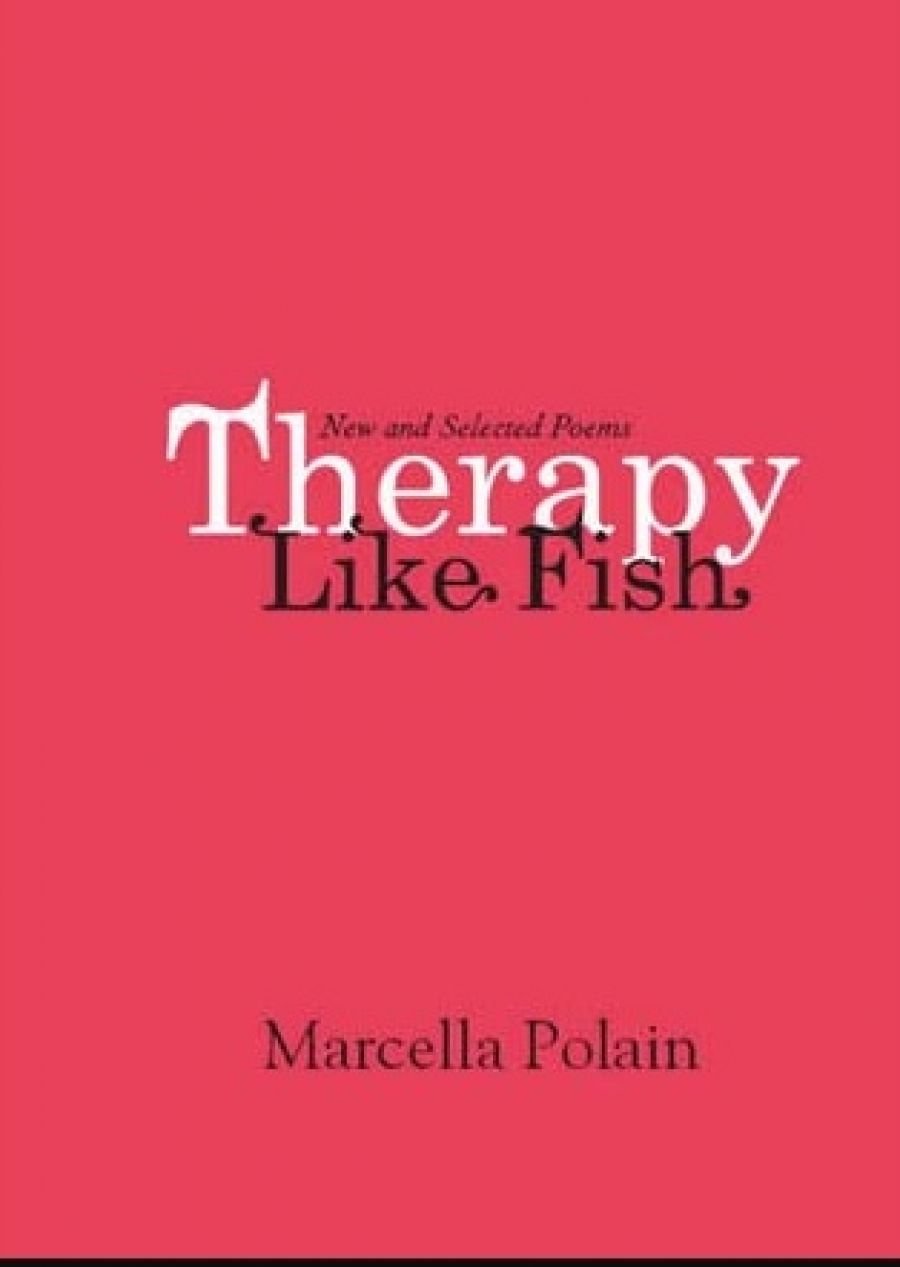
- Free Article: No
- Contents Category: Poetry
- Review Article: Yes
- Online Only: No
- Custom Highlight Text:
Marcella Polain’s latest book of poems continues her lyrical exploration of personal experience. Her earlier collections centred on immigrant life, shadowed by a violent history, in the adopted context of the Western Australian wheat belt. In the new poems, which occupy more than one third of the current volume, the emotional terrain has thickened, and the range of experience has expanded to include midlife concerns of failing health, ageing parents and death. ‘So this is what life is,’ Polain writes, ‘nausea, vertigo, migraine, cramps.’ One poem describes the extra chores of helping her mother, and ends: ‘Last Sunday you couldn’t remember who I was or / what you wanted me to buy for you.’
- Book 1 Title: Therapy Like Fish
- Book 1 Subtitle: New and selected poems
- Book 1 Biblio: John Leonard Press $24.95 pb, 154 pp
- Book 1 Readings Link: booktopia.kh4ffx.net/bARMb
Polain’s work gives primacy to the image. Her effects are often built from the simplest materials: ‘Pull in the sails of wind and language. / Fill our hands and mouths with cloth.’ Sails, wind, hands, mouths, cloth: everyday things – words that could have been lifted from a toddler’s picture book – are here combined into a powerful image. The sudden abstraction of that word ‘language’ is a deft touch, one used by Auden in his lines, ‘O dear white children casual as birds, / Playing among the ruined languages’ – that sudden abstraction getting the phrase airborne. C. Day Lewis quoted Auden’s lines in The Poetic Image (1947) to illustrate how the word ‘white’ carries connotations of ‘distance, separation, and a certain nostalgic melancholy’.
Polain knows that white has its distancing effect. In one poem about a consultation with a medical specialist, she leaves ‘with a fistful of curt white petals’.
Polain is sensitive to the effects of colour, and colour words appear often in her work, amid the vivid details of everyday life. There is the ‘blue bicycle against the pink wall’, a lemon organza childhood dress and a green dry cleaner’s ticket pinned to a coat. In one poem, she describes hair shining like ‘wet black paint’, echoing those ‘petals on a wet, black bough’ in Ezra Pound’s archetypal imagist poem.
Sometimes Polain carries the childhood simplicity of words into the images themselves, straightforward and physical: ‘the red brick wall / the green gate / the yellow rose’, which may owe something to William Carlos Williams’s iconic red wheelbarrow.
One can trace a line in Polain’s work back to influences from her Armenian heritage. Her PhD thesis was on the Armenian genocide, and her novel The Edge of the World (2007) was based on her family’s survival. In the poem ‘writer’s subject’, she writes:
let me steep rose petals for you
halve eggplants set yoghurt in a cloth
& swing it in a window
let me teach you how to dance
& read you poetry by Tekeyan
Vahan Tekeyan was an Armenian poet who spent much time in Egypt and Constantinople, and in 1914 was appointed as the permanent representative of the Armenian National Assembly in Jerusalem, which was how he came to escape the genocide. His work is laden with sadness, and a love of his country and people. There is also, as with Polain, an understanding of the power of simplicity, which he couples with a classical restraint. Absence from calamitous events can permeate every aspect of the subsequent life and the work of an artist. Survivors and their descendants are – through time’s passage – exiled from the ever-traumatic events; Polain writes of ‘each cell bloody with memory’.
Polain has an ear for the euphonies of language. In the poem ‘A curled submariner’, she threads her way through imagery, waking from heavy sleep, and ‘the life before / this brisk one’, to an in utero sort of existence ‘where each heart is / the loudest thing’. Early in the poem come the lines ‘so close to the close / of this crowded thousand years’. Here, the play on the two versions of ‘close’ and the chiming of ‘crowded’ and ‘thousand’ are the sorts of things that Addison disliked in Milton, calling it ‘a kind of jingle in his words’. Now, post-Hopkins, it is standard technique. In Polain’s work, it forms just one part of the supporting fabric of her meditative personal narratives, in which – through the sort of inwardness that Bly extolled – the exterior world is rendered new and strange. ‘A curled submariner’ ends with a description of Polain’s children and others at a primary school, climbing into a tiny red submarine. There is a second layer of meaning: ‘One by one, / the children had their turn inside.’ Finally, a boy leaps out, wide-eyed, voice trembling:
It’s too loud, he said.
What is? laughed the man.
I am, he replied. It seems like I’m a monster in there.


Comments powered by CComment